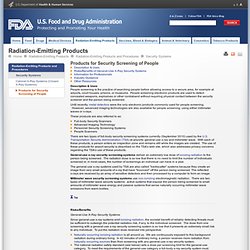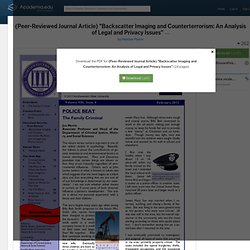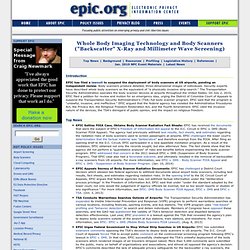

TSA removes body scanners criticized as too revealing. The TSA had developed protocols to assure that screeners who saw imagery of passengers never saw the passengers themselves.

Backscatter full-body scanners generated controversy Critics said images were too revealing, others cited potential health concernsTSA says it has met June 1 deadline to remove machines from airportsAirport full-body screening will use different technology Washington (CNN) -- The harshest critics labeled them "virtual strip searches. " Airport passenger screening that produced particularly realistic full-body images using backscatter technology. Others also expressed health concerns about low doses of radiation from the X-rays underpinning those scans. Well, it's all over now as the Transportation Security Administration says it has met a June 1 deadline to remove all 250 backscatter machines from U.S. airports.
Dr. Joseph Mercola: Airport Scanners: Radiation Is Not the Only Health-Hazard. There are about 350 full-body scanners being used in close to 70 U.S. airports, and that number is expected to increase to 1,000 scanners by the end of 2011.

Dubbed "naked" scanners because they give a graphic image of your body, including genitalia and other personal effects like sanitary napkins, the devices are raising privacy and health concerns among frequent travelers and pilot groups alike. The alternative is also causing outrage. R42750. University of Waikato Web Login.
X-Ray Airport Security Scanners: Serious Health Risks. Whole Body Backscatter X-Ray Airport Security Scanners: Serious Health Risks for Air Travel Passengers by Profs.

John Sedat and Elizabeth Blackburn Global Research, November 29, 2010 GlobalResearch.ca The following is a letter from members of the University of California San Francisco - to Dr John P Holdren, Assistant to the President for Science and Technology Dear Dr Holdren, We, a number of University of California, San Francisco faculty, are writing -- see attached memo -- to call to your attention our concerns about the potential serious health risks of the recently adopted whole body backscatter X-ray airport security scanners. By way of introduction one of us (John Sedat) met you recently when he and his wife Dr Elizabeth Blackburn, a 2009 Nobel Laureate, talked with President Obama last December. Dr Sedat is Professor Emeritus in Biochemistry and Biophysics at the University of California San Francisco, with expertise in imaging.
Sincerely Yours The Red Flags © Scoop Media. Welch-Body-Scanners. Products for Security Screening of People. Description & UsesPeople screening is the practice of searching people before allowing access to a secure area, for example at airports, court houses, prisons, or museums.

People screening electronic products are used to detect concealed weapons, explosives or other contraband without requiring physical contact between the security screener and the person being screened. Until recently, metal detectors were the only electronic products commonly used for people screening. However, advanced imaging technologies are also available for people screening, using either millimeter waves or x-rays. (Peer-Reviewed Journal Article) "Backscatter Imaging and Counterterrorism: An Analysis of Legal and Privacy Issues" Police Beat The Family Criminal.

Scenihr_o_036. Broadcast Yourself. TSA Backscatter X-ray Backlash. Things are happening so fast that I don't know if I should bother.

But here are some links and observations. The head of the Allied Pilots Association is telling its members to avoid both the full body scanners and the patdowns. This first-hand report, from a man who refused to fly rather than subject himself to a full-body scan or an enhanced patdown, has been making the rounds. (The TSA is now investigating him.) It reminds me of Penn Jillette's story from 2002. A woman has a horrific story of opting-out of the full body scanners.
Sadly, I agree with this: It is no accident that women have been complaining about being pulled out of line because of their big breasts, having their bodies commented on by TSA officials, and getting inappropriate touching when selected for pat-downs for nearly 10 years now, but just this week it went viral.
Seems that once you enter airport security, you need to be subjected to it -- whether you decide to fly or not. Nor this story. And once as saying: Whole Body Imaging Technology and Body Scanners ("Backscatter" X-Ray and Millimeter Wave Screening) Introduction EPIC has filed a lawsuit to suspend the deployment of body scanners at US airports, pending an independent review.

Body scanners produce detailed, three-dimensional images of individuals. Security experts have described whole body scanners as the equivalent of "a physically invasive strip-search. " The Transportation Security Administration operates the body scanner devices at airports throughout the United States. On July 2, 2010, EPIC filed a petition for review and motion for an emergency stay, urging the District of Columbia Court of Appeals to suspend the Transportation Security Administration's (TSA) full body scanner program.
Top News EPIC Settles FOIA Case, Obtains Body Scanner Radiation Fact Sheets: EPIC has received the documents that were the subject of EPIC's Freedom of Information Act appeal to the D.C. Background A passenger is scanned by rastering or moving a single high energy x-ray beam rapidly over their form.